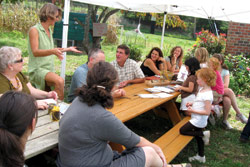To achieve the goal of eating closer to home, last month some food activists took a trip to a very faraway place.
Asheville's Appalachian Sustainable Agriculture Project this fall hosted its first-ever Local Food Institute, designed to familiarize local-food-market developers from Tennessee to Toledo with ways to energize their economies. For three days, participants tromped around downtown Asheville, eating lunch in the Isaac Dickson cafeteria, touring Greenlife Grocery and confabbing with the tourism officials who've crafted the Foodtopian Society initiative, helping to thrust edible experiences to the top of many Asheville visitors' itineraries.

As the event proved, while locally grown food may lure folks to Asheville, the region's reputation as a place that does local food right may offer still more development opportunities. Kale and eggs and goat cheese aren't unique to Asheville, but — as nearly every seminar attendee noted — the area's unbridled enthusiasm and institutional support for such humble foodstuffs is nearly unmatched. Asheville could very well be poised to emerge as Locavore U.
"The vastness of the local food community around there is impressive," participant Leslie Hossfeld said after returning to her home in Wilmington. "It's certainly not what we have down here."
According to Hossfeld, pervasive poverty in southeastern North Carolina has kept local food from finding a foothold: "People here are just concerned about eating, so they're not concerned about where it comes from," she says. Still, she's working with colleagues to support limited-resource farmers by driving up demand for their products. That's no easy task in a region where the big money's spent by visiting tourists who come to the coast craving fried shrimp, not freshly picked peanuts.
While nobody involved in the Institute disputed Hossfeld's description of the challenges she'd faced while trying to stimulate a vibrant local-food scene, her difficulties provoked an onslaught of suggestions from fellow enrollees at the opening night dinner. Was she working with local schools? Had she consulted local chefs? Did her organization have an informative Web site? (Yes, yes and yes.)
"I'm overwhelmed," Hossfeld sighed over a hearty group breakfast at Early Girl Eatery the following morning. "I'll just have to listen."
There was certainly no shortage of conversations on which to listen in. The institute's nearly two-dozen participants spent much of their limited free time swapping philosophies and floating theories that reflected their home soil as surely as the tomatoes that grew in it this summer.
Noah Ranells, for example, was a stickler for accountability. Agricultural coordinator for the largely urban Orange County, N.C., Ranells believes restaurants should be forced to reveal what percentage of food on their menu is derived from local sources.
"That's one of the things I'm interested in pushing," Ranells said, visibly disappointed that Early Girl's owner Julie Stehling — whose local-food credentials are considered impeccable by serious Asheville eaters — couldn't immediately calculate a local-to-imported ratio.
"What's the percentage?" he continued. "I'm way beyond finding the phrase 'we use local whenever possible' acceptable."
ASAP hasn't ever endorsed such a hard-line strategy, as its executive director, Charlie Jackson, explained. Perhaps not surprisingly, the Asheville model of local-food culture is fairly inclusive, attributing the very best intentions to its adherents.
"These restaurants need the full spectrum of fruits and vegetables, and they need them year-round," Jackson said after considering Ranells' suggestion. "We start with people where they are."
Ranells shook his head, still affable but apparently not persuaded.
"The fear I have is folks who don't have integrity," he emphasized. "I'm just looking for a threshold."
"But it's different for every place!" protested Emily Jackson, director of ASAP's farm-to-school program.
"We want to make it as open as we possibly can," Charlie Jackson added. "We want to make it as easy as we possibly can."
Making local food easy for restaurateurs, eaters, farmers, grocers, school systems and city leaders was at the very heart of the Institute's programming, which officially kicked off with a short lecture by Charlie Jackson.
"One thing is to learn what we did, but I really want you to learn why we did it," Jackson told the enrollees. "It is a mountain solution. Parts of it are going to be very applicable, but you don't just take something you've seen somewhere else and plop it into your community. We want you to be thinking about what you want to do when you get home."
After returning from Asheville, Hossfeld's team decided to vigorously pursue a branding project they'd previously explored.
"We have a logo, but we want to morph into something more powerful," Hossfeld said. "We learned some things from ASAP. We feel like if we keep at it, one day we'll be there too."
Hanna Rachel Raskin can be reached at food@mountainx.com.



Thanks Hanna for this great article. It is exciting to see the level of interest from all over the country in building local markets for farms and remaking connections to where food comes from. I would like to clarify one thing – where I am quoted as saying “we want to make it easy,” it reads like we want to make it easy for people to claim they are buying local but maybe are not. What I mean is that ASAP has been working to make local food available in so many places that it is easy for a restaurant or shopper to find and chose food from local farms. We do this through our Local Food Guide, our farm to chef directory the Mixing Bowl, through the dozens of farmers tailgate markets we support, through or Appalachian Grown branding effort, and through working with distributors and wholesalers to make sure that there are literally dozens of easy ways to connect with local farmers.